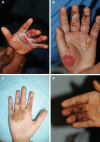Upper Extremity Friction Burns in the Pediatric Patient: A 10-year Review
- PMID: 30656122
- PMCID: PMC6326592
- DOI: 10.1097/GOX.0000000000002048
Upper Extremity Friction Burns in the Pediatric Patient: A 10-year Review
Abstract
Background: Upper extremity friction burn due to powered home equipment is a growing problem in the pediatric population. The purpose of this study was to review the etiology, presentation, characteristics, and treatment of this particular type of pediatric mechanism of injury.
Methods: A retrospective chart review using International Classification of Diseases, version 9, codes for patients treated at a large tertiary care, free-standing children's hospital was performed to identify all patients presenting with an upper extremity friction burn from 2003 to 2012.
Results: Sixty-nine patients sustained upper extremity friction burns. The average age at the time of injury was 3.3 years (range, 0.7-10.6) with presentation to our center occurring 16.6 days (range, 0-365 days) following injury. Mean follow-up was 23.3 months (range, 2-104). Mechanism of injury included treadmills (n = 63) and vacuum cleaners (n = 6). Twenty-eight operations were performed on 21 patients (30%). All patients requiring a surgical intervention sustained injury via treadmill mechanism (P = 0.0001). Unlike treadmill burns, vacuum cleaner injuries affected the dorsal hand or a single digit (P = 0.00004). Scar hyperpigmentation was more prevalent in these patients compared with the treadmill group (P = 0.003). All vacuum-induced burn patients had full range of motion and function with conservative treatment alone, whereas only 55.6% of treadmill burn patients had full recovery of range of motion and 50.8% recovery of full hand function.
Conclusions: Friction burns from vacuum cleaners are less prevalent, have different injury patterns, and can be treated conservatively with excellent functional outcomes. Treadmill friction burns result in more significant injury and risk for dysfunction, requiring surgical intervention.
Figures



References
-
- Prasetyono TO, Sadikin PM, Saputra DK. The use of split-thickness versus full-thickness skin graft to resurface volar aspect of pediatric burned hands: a systematic review. Burns. 2015;41:890. - PubMed
-
- Menon S, Ward D, Harvey JG, et al. Friction burns in children: does laser Doppler imaging have a role? J Burn Care Res. 2012;33:736. - PubMed
LinkOut - more resources
Full Text Sources
